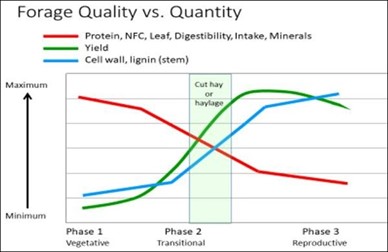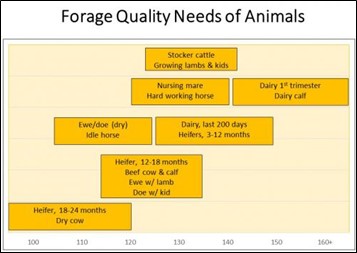The first cutting of hay should be your first priority for dairy forages
Dairy farms should prioritize the first cutting of alfalfa over other ongoing field tasks to ensure a high quality haylage .

As field work ramps up across Michigan in May and June, the list of chores that need to be accomplished continues to grow for dairy producers. Many farms are trying to balance planting, manure spreading and other field work on top of everyday chores. As the calendar continues to move forward and the weather warms up, one important task is rapidly approaching – the first cutting of alfalfa.
The first cutting is often perceived as the most important task to start the rest of your harvest season off well. Traditionally the highest yielding, the first cutting will account for the biggest proportion of your total yield for the season. Due to its higher yield, it also presents the highest risk of decreased quality if not harvested on time.

As yields continue to increase on your alfalfa stand, quality quickly decreases (Fig 1). This is due to a higher stem-to-leaf ratio in the plant as it grows. As stems make up a bigger portion of the plant, the fiber content (NDF) increases, which decreases digestibility and reduces the nutrients absorbed by the cow. This date also determines your second, third, fourth and potentially fifth cutting windows, as days after cutting is the criteria used to establish the rest of your alfalfa growing/harvesting season. Forage quality should be the top goal for dairies as they harvest alfalfa for haylage. Therefore, establishing the sweet spot between quality and yield should be a key goal for dairy farms.
Now that we have established the importance of harvesting at the optimal time, the question is: how do we establish the time for first cutting? Multiple resources are available to establish the optimal cutting day, and using more than one tool will provide a more accurate result. Let’s briefly review some of the methods that can be used to determine the sweet spot to optimize both quality and yield of your alfalfa crop.
Growing Degree Days (GDD) is a measure of how many heat units the plant has been exposed to above its base temperature (41°F for alfalfa). Therefore, GDD establishes the days when the plant was active and estimates the energy received for growing. This can be used to get a reference of when the plant is ready for harvest. For first cutting alfalfa, Mike Allen recommends the target to be 680-750 GDD. Its optimal value within the range is determined by the facility used for storage.
However, this target number should not be the only factor used to determine the decision to harvest. It will simply provide an indicator for when to go out to the field and scout the plants to perform further assessments. If you are interested in how to perform this calculation, please take a look at the following article from Penn State University Extension, or reach out to your local MSU Extension educator.
Plant height can also provide a good indicator of estimated maturity. Phil Kaatz shared during a recent forage field day at Michigan State University that once the tallest plants (at the bud stage) in a field reach 28 inches of height, plants are typically at the optimal point for harvest.
Predictive Equations for Alfalfa Quality (PEAQ). These equations also use plant height to estimate multiple metrics of feed quality. They are easily used in farms by using a PEAQ stick. The stick can be used in the field to estimate relative feed value (RFV), relative feed quality (RFQ), and neutral detergent fiber (NDF) content of the plants. Is important to establish that these values are estimated and should be used for reference only. To obtain actual values used for evaluation and ration formulation MSU Extension recommends sampling and testing by a certified laboratory. If you are interested, a quick step-by-step guide on using the PEAQ stick can be accessed here. Reference RFQ values to establish first cutting dates are shown in Table 1, which shows that this decision should be made according to your forage usage goals.
Recent scouting in multiple fields across different regions of the state show that the date for first cutting is approaching quickly, as the unusually warm weather this spring has provided a head start for plant growth, potentially moving the date for first cutting earlier in 2024 compared to recent years. For many farms the earlier date means that the window for first cutting will likely occur during the middle of corn planting. Many producers will need to decide if they will finish planting before moving to alfalfa harvest or focus on alfalfa, delaying the planting of corn. Kim Cassida, a forage expert from Michigan State University Extension, recommends that dairy producers should put the corn planter away, the corn will be fine, but the alfalfa needs to be harvested.
Delaying corn planting by a couple of days will have minimal to no effect on the harvest quality in the fall. However, as seen in Figure 1, delaying your alfalfa cutting date could have a significant impact on the quality of your haylage. Research has shown that forage quality can decrease at a rapid rate past the sweet spot.

Each day you delay cutting alfalfa, you are sacrificing forage quality, which should be priority one on dairy farms. As a result, a 3-4 day delay while you finish your corn planting could turn your high-quality first cutting fuel for lactating cows into a low-quality forage only useful for dry cows or heifers. This can impact your lactation forage inventories for the year. The first cutting is the one with maximum yields, therefore dairy farms should prioritize quality and timeliness on first cutting alfalfa.
For additional questions, information or field evaluation, reach out to Martin J. Carrasquillo Mangual by emailing carrasq1@msu.edu or reach out your herd’s dairy nutritionist.



 Print
Print Email
Email

